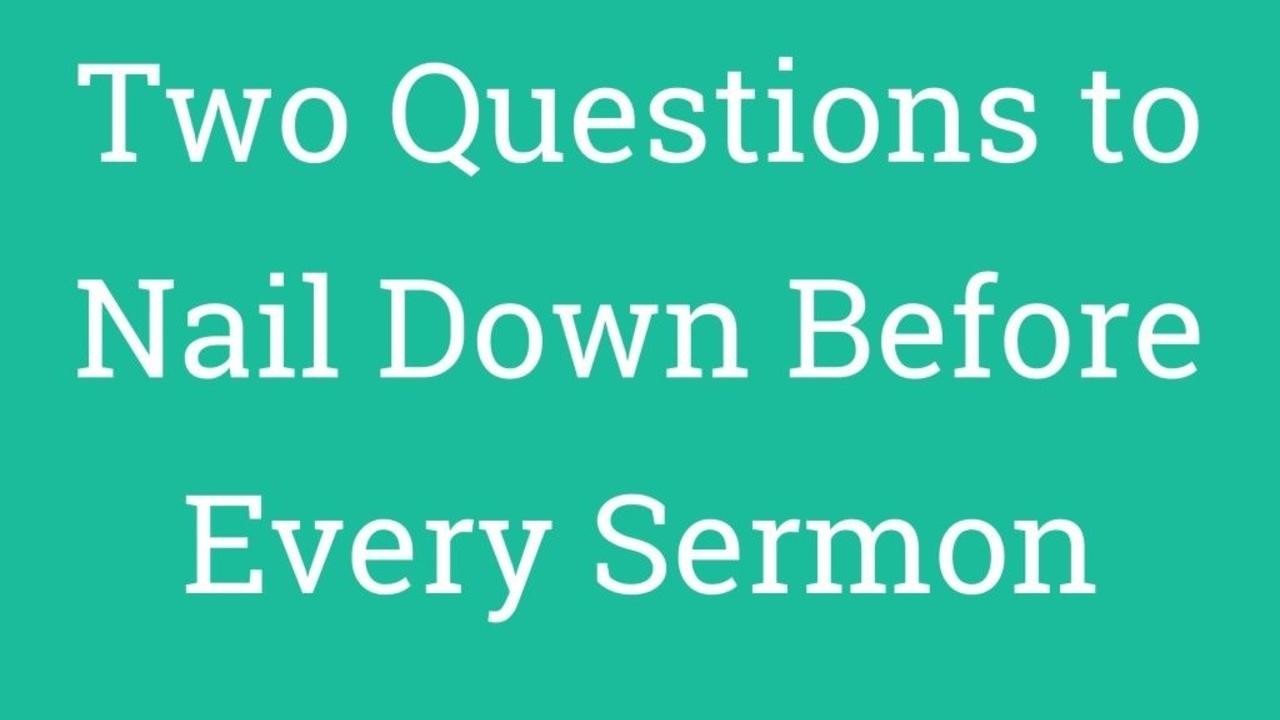Two Questions to Nail Down Before Every Sermon

To know if you were successful at something you’ve tried, you have to know what you were seeking to accomplish. This is true in every area of life but especially in preaching. This is why I nail down two questions before every sermon. These two questions are an essential part of my sermon preparation process, and I want to share them with you.
1. What is the objective for this sermon?
When you think back on a sermon you’ve preached you should know if you met your objective. Nothing is more frustrating than putting lots of work into a sermon and having no way to measure its effectiveness. But to assess the sermon you need an objective to measure it against. And to meet an objective, you must have an objective. So what exactly is a preaching objective?
A preaching objective is simply what you want the sermon to do. A sermon should be more of a verb than a noun. A sermon should work. It should accomplish things.
But your sermon only accomplishes what you make it accomplish. Your sermon only works as hard as you do. It’s essential to understand exactly what you want your sermon to do before you preach it. This is your preaching objective.
Example objectives: This sermon will…
-show how knowing your identity in Christ makes a difference in your relationships
-teach people how to pray
-demonstrate how God has worked all throughout history
-show how this Old Testament passage points to Jesus
-show how to understand and apply this passage of scripture
-teach people what biblical giving looks like and how to do it
Every sermon needs a purposeful objective. If you have not clearly defined the objective for your sermon, you won’t know if you’ve hit it.
Coming up with an objective. To decide on an objective I ask some questions during my preparation.
What’s the point of this text?
What’s the theme of this preaching series?
What am I trying to get across?
What is the most important thing for them to remember?
What matters most for THIS sermon?
What’s not as important for THIS sermon?
These questions help me narrow down exactly what I want my sermon to do. Before I get too far in my preparation, I write down the objective. Nailing down an objective is important, but it’s incomplete without accompanying application. Your sermon needs a desired response.
2. What is the desired response for this sermon?
What is a desired response? If the objective is what your sermon is to do, the desired response is what your listeners are to do with the sermon. If the sermon works like it’s supposed to, your listeners will know exactly what they are to do in response. Put another way, a desired response is how you want your sermon to be applied.
To set a desired response, define ahead of time what it looks like to apply your message. If your objective is met, the response will complement it perfectly.
A desired response to it helps ensure that your listeners walk away from your sermon knowing exactly how they can apply the message to their lives.
Example desired responses: When people walk away from this sermon they will
-take a step toward living in light of their identity in Christ
-begin an intentional daily prayer time
-understand God’s redemptive work in history and trust him with their future
–embrace how all of life points to Jesus and his redeeming work
-study this passage further and apply it to their lives
-begin giving financially to their local church
Coming up with a desired response: I ask some questions of the sermon to decide on a desired response.
What would it look like to apply this text?
How would my life be different if I actually believed this?
What is the most important step to take to apply this message?
How does this message hit home in people’s lives?
How does this message challenge, convict, motivate, or comfort people?
Desired responses are flexible. God works on different people in different ways through the same message. So I am not disappointed if someone applies my message in a way other than I desired. There may be dozens of ways to apply a message.
The desired response is a preparation aid. If I know what my message could look like if someone put it on like a jacket and wore it out, then it helps me prepare with the end in mind.
For every sermon I preach I nail down the objective and the desired response as part of my preparation process. This initial stage is accomplished in a team which I wrote about in a three-part series on preaching teams.
Conclusion
The objective and desired response is mostly for you to know. I’m not suggesting you get up and say, “Okay, everyone my objective is… and my desired response is…” That would most likely produce a collective yawn. When you have clearly defined your objective and desired response they will come out in your message. You don’t have to announce them. They will work themselves out naturally as you preach in a way that matches your objective and aims at your desired response.
On the other hand, if you don’t have an objective your listeners will know that you don’t. If you don’t know how your sermon could be applied, your listeners probably won’t know either. You must know these, and be confident in them.
This is why I make answering these two questions a top priority early on in my prep process. What about you? How do you think through what you want your sermon accomplish?


